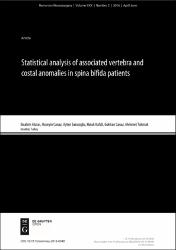| dc.contributor.author | Alataş, İbrahim | |
| dc.contributor.author | Canaz, Hüseyin | |
| dc.contributor.author | Saraçoğlu, Ayten | |
| dc.contributor.author | Kafalı, Haluk | |
| dc.contributor.author | Canaz, Gökhan | |
| dc.contributor.author | Tokmak, Mehmet | |
| dc.date.accessioned | 2016-10-06T11:04:42Z | |
| dc.date.available | 2016-10-06T11:04:42Z | |
| dc.date.issued | 2016 | |
| dc.identifier.citation | Alatas I, Canaz H, Saracoglu A, Kafali H, Canaz G, Tokmak M. Statistical analysis of associated vertebra and costal anomalies in spina bifida patients. Romanian Neurosurgery. 2016; 30 (2): 258–266. doi: 10.1515/romneu-2016-0040 | en_US |
| dc.identifier.issn | 1220-8841 | |
| dc.identifier.uri | https://www.degruyter.com/view/j/romneu.2016.30.issue-2/romneu-2016-0040/romneu-2016-0040.xml?format=INT | en_US |
| dc.identifier.uri | https://hdl.handle.net/11446/1109 | en_US |
| dc.description | İstanbul Bilim Üniversitesi, Tıp Fakültesi. | en_US |
| dc.description.abstract | Objective: Spina bifida is one of the most severe birth defects and can happen as a result of disrupted primary neurulation. Congenital vertebra and costa anomalies are more frequently seen with spina bifida, and associated anomalies significantly affect the prognosis of affected children. In this study, we aimed to determine the incidence of scoliosis, costal anomalies, and vertebral deformations seen at the time of diagnosis and to statistically evaluate their concomitancies.
Methods: Gender and mean ages of the patients were determined. The spina bifida patients were examined for deformation anomalies, butterfly vertebra, hemivertebra, wedge vertebra, costal anomalies and scoliosis. The relationships between these anomalies were evaluated.
Results: 94 patients with a mean age of 11,5 months examined. The incidence of scoliosis was 21.8% among female infants and 17.9% among males. Rates of scoliosis with vertebra anomalies (hemivertebra, wedge vertebra) and costal anomalies did not differ significantly (P > 0.05). Wedge vertebra were the most frequent vertebra anomaly type with 38.2% ratio. Costal anomalies were detected in 25.5% of females and 20.5% of male infants. Hemivertebra and wedge vertebra were seen significantly more frequently in this group. Gender distribution did not differ between with and without any vertebra types.
Conclusion: Congenital vertebra and costa anomalies are more frequently seen with spina bifida. We believe that these anomalies and relationship with spina bifida may demonstrate differences among different ethnic groups or locations. More detailed multi-centered studies performed on this issue will aid in the determination of etiologies, genetics, and treatment principles of these congenital anomalies. | en_US |
| dc.language.iso | eng | en_US |
| dc.publisher | De Gruyter Open / Romanian Society of Neurosurgery | en_US |
| dc.identifier.doi | 10.1515/romneu-2016-0040 | en_US |
| dc.rights | info:eu-repo/semantics/openAccess | en_US |
| dc.subject | costal anomalies | en_US |
| dc.subject | scoliosis | en_US |
| dc.subject | spina bifida | en_US |
| dc.subject | hemivertebrae | en_US |
| dc.subject | wedge vertebrae | en_US |
| dc.title | Statistical analysis of associated vertebra and costal anomalies in spina bifida patients | en_US |
| dc.type | article | en_US |
| dc.relation.journal | Romanian Neurosurgery | en_US |
| dc.department | DBÜ, Tıp Fakültesi | en_US |
| dc.identifier.issue | 2 | |
| dc.identifier.volume | 30 | |
| dc.identifier.startpage | 258 | |
| dc.identifier.endpage | 266 | |
| dc.contributor.authorID | TR113559 | en_US |
| dc.contributor.authorID | TR152967 | en_US |
| dc.contributor.authorID | TR193017 | en_US |
| dc.contributor.authorID | TR55670 | en_US |
| dc.contributor.authorID | TR183102 | en_US |
| dc.relation.publicationcategory | Belirsiz | en_US |


















